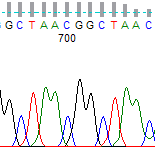The q count trim option allows end trimming of the low quality regions of the basecall using a count of q score below a set threshold using a window of variable size. This trim option is a combination of 3 parameters; a quality score threshold, the number of bases below this threshold, and the size of the sliding window used over which the count is performed.
The basecalls are scanned from both ends using a sliding window starting of the selected size. The trace is trimmed when fewer than the selected number of bases have a quality score below the chosen value in the window. For example if the Q value is set to 20, the bases set to 4, and the window size set to 20, the trace would be trimmed from the 5′ and 3′ ends when a window of 20 bases contains fewer than 4 bases with a Q score below 20.
Below are some examples of the q count trimming option.

Figure 1. An example of an untrimmed trace.

Figure 2. The same trace trimmed with Q Count parameters: Q value 36, 10 bases and a sliding window of 20.
From Figure 1 & 2 we can see a region with mid range Q scores starting from base 706. Once Q Count Trimming was applied it trimmed the trace at this region as it contained more than 10 bases with a quality value of 35 or less in a window of 20 bases.
The q average trimming option is compatible with the set abi limits option, which will perform a soft or “virtual” trim of low quality end regions which shows the trimmed bases as grey when viewed in ABI’s Trace Viewer software.
If you have untrimmed traces that have already been processed through PeakTrace and you would like to trim them without being charged more units, you can perform post-process trimming by selecting abi/kb as the basecaller and choosing the appropriate trimming method. Remember to turn off the clean baseline, extra baseline and extra normalization options or you may be charged for trimming the traces.